India FDI: Political, Economic, and Socio-cultural Influences
VerifiedAdded on 2023/06/12
|11
|1092
|425
Report
AI Summary
This report provides a comprehensive analysis of Foreign Direct Investment (FDI) in India, examining the political, economic, socio-cultural, and technological factors that influence investment opportunities. It explores India's national resource endowments, competitive advantages, foreign currency exchange dynamics, and existing trade policies, systems, barriers, and incentives. The report also reviews current levels of FDI and offers recommendations based on the assessment, highlighting the positive correlation between FDI inflows and economic growth in India, emphasizing the importance of favorable trading climates and robust business strategy measures to attract foreign investors. The document concludes with a summary of FDI trends and a list of references used for the analysis. Desklib is a platform which provides all the necessary AI based study tools for students.

INTERNATIONAL BUSINESS ACROSS BORDERS
Paraphrase This Document
Need a fresh take? Get an instant paraphrase of this document with our AI Paraphraser
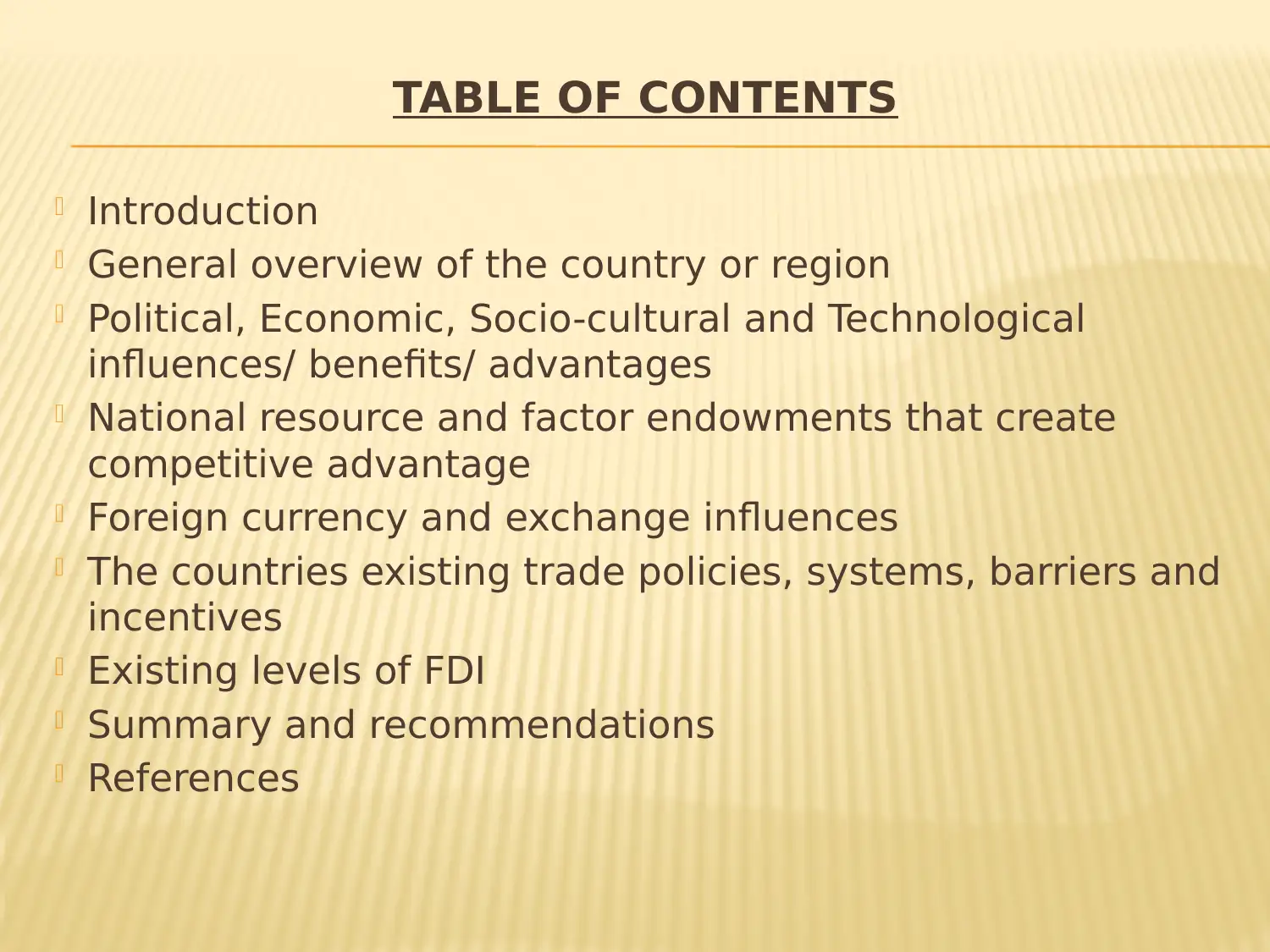
TABLE OF CONTENTS
Introduction
General overview of the country or region
Political, Economic, Socio-cultural and Technological
influences/ benefits/ advantages
National resource and factor endowments that create
competitive advantage
Foreign currency and exchange influences
The countries existing trade policies, systems, barriers and
incentives
Existing levels of FDI
Summary and recommendations
References
Introduction
General overview of the country or region
Political, Economic, Socio-cultural and Technological
influences/ benefits/ advantages
National resource and factor endowments that create
competitive advantage
Foreign currency and exchange influences
The countries existing trade policies, systems, barriers and
incentives
Existing levels of FDI
Summary and recommendations
References
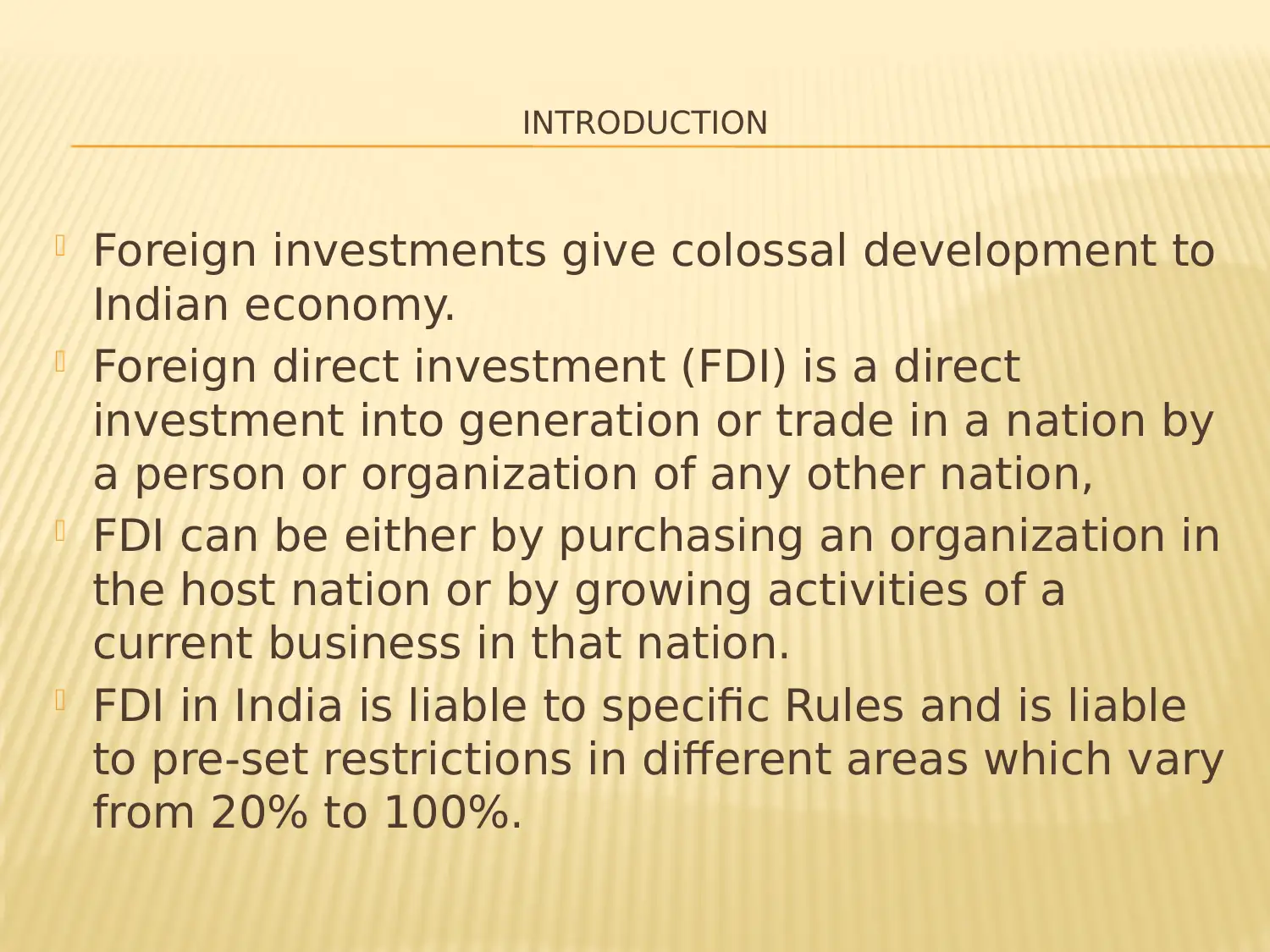
INTRODUCTION
Foreign investments give colossal development to
Indian economy.
Foreign direct investment (FDI) is a direct
investment into generation or trade in a nation by
a person or organization of any other nation,
FDI can be either by purchasing an organization in
the host nation or by growing activities of a
current business in that nation.
FDI in India is liable to specific Rules and is liable
to pre-set restrictions in different areas which vary
from 20% to 100%.
Foreign investments give colossal development to
Indian economy.
Foreign direct investment (FDI) is a direct
investment into generation or trade in a nation by
a person or organization of any other nation,
FDI can be either by purchasing an organization in
the host nation or by growing activities of a
current business in that nation.
FDI in India is liable to specific Rules and is liable
to pre-set restrictions in different areas which vary
from 20% to 100%.
⊘ This is a preview!⊘
Do you want full access?
Subscribe today to unlock all pages.

Trusted by 1+ million students worldwide
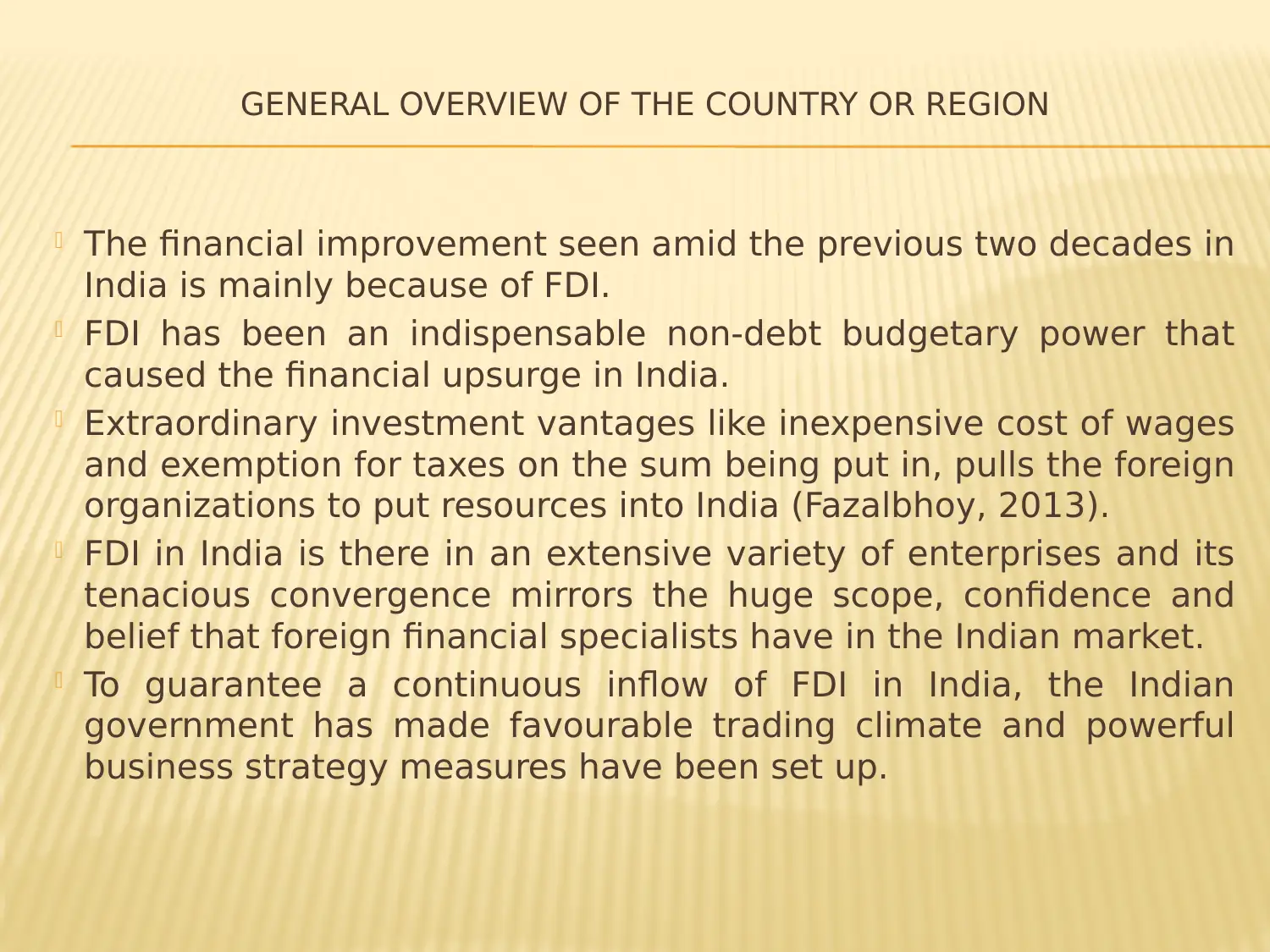
GENERAL OVERVIEW OF THE COUNTRY OR REGION
The financial improvement seen amid the previous two decades in
India is mainly because of FDI.
FDI has been an indispensable non-debt budgetary power that
caused the financial upsurge in India.
Extraordinary investment vantages like inexpensive cost of wages
and exemption for taxes on the sum being put in, pulls the foreign
organizations to put resources into India (Fazalbhoy, 2013).
FDI in India is there in an extensive variety of enterprises and its
tenacious convergence mirrors the huge scope, confidence and
belief that foreign financial specialists have in the Indian market.
To guarantee a continuous inflow of FDI in India, the Indian
government has made favourable trading climate and powerful
business strategy measures have been set up.
The financial improvement seen amid the previous two decades in
India is mainly because of FDI.
FDI has been an indispensable non-debt budgetary power that
caused the financial upsurge in India.
Extraordinary investment vantages like inexpensive cost of wages
and exemption for taxes on the sum being put in, pulls the foreign
organizations to put resources into India (Fazalbhoy, 2013).
FDI in India is there in an extensive variety of enterprises and its
tenacious convergence mirrors the huge scope, confidence and
belief that foreign financial specialists have in the Indian market.
To guarantee a continuous inflow of FDI in India, the Indian
government has made favourable trading climate and powerful
business strategy measures have been set up.
Paraphrase This Document
Need a fresh take? Get an instant paraphrase of this document with our AI Paraphraser
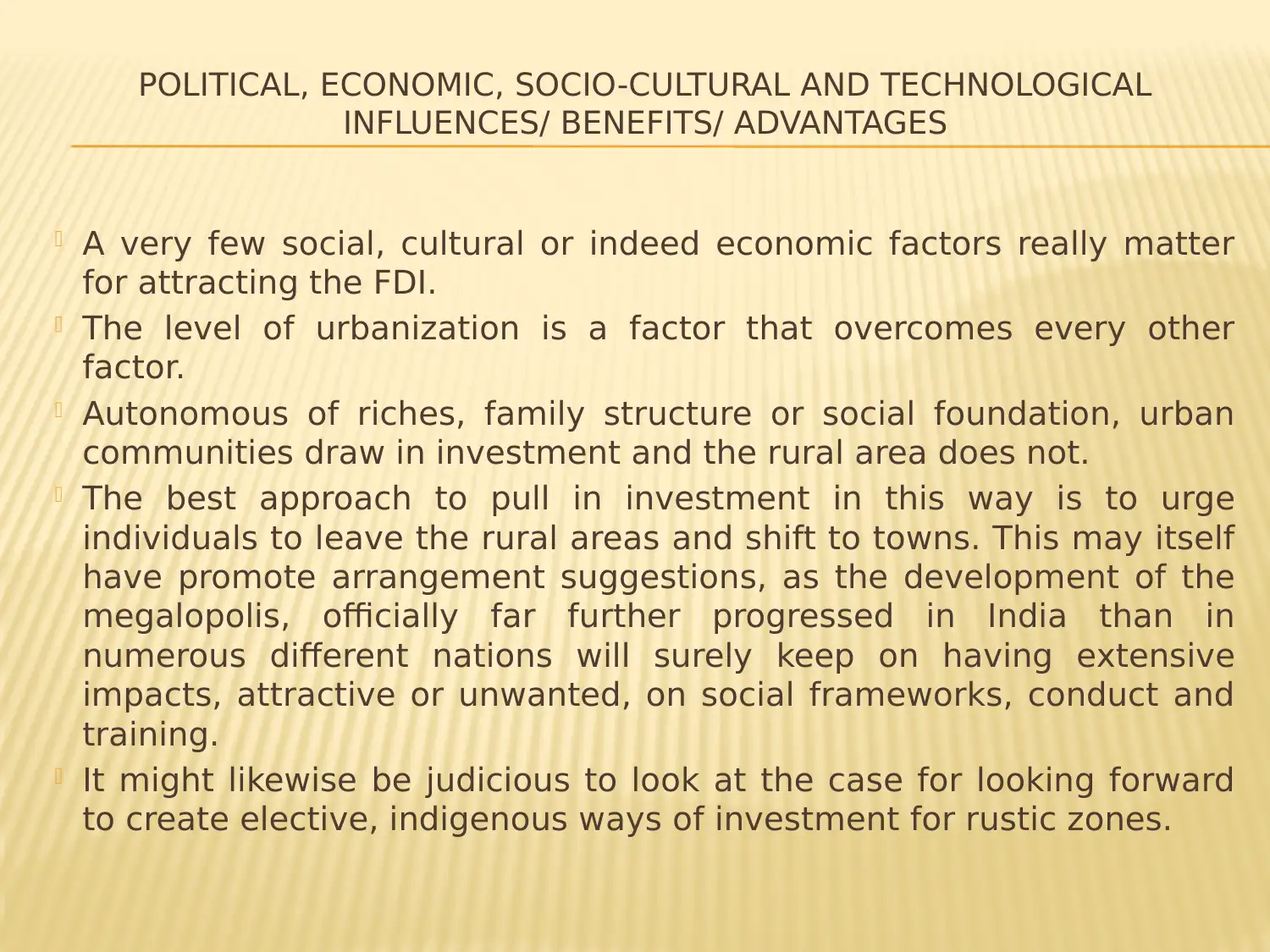
POLITICAL, ECONOMIC, SOCIO-CULTURAL AND TECHNOLOGICAL
INFLUENCES/ BENEFITS/ ADVANTAGES
A very few social, cultural or indeed economic factors really matter
for attracting the FDI.
The level of urbanization is a factor that overcomes every other
factor.
Autonomous of riches, family structure or social foundation, urban
communities draw in investment and the rural area does not.
The best approach to pull in investment in this way is to urge
individuals to leave the rural areas and shift to towns. This may itself
have promote arrangement suggestions, as the development of the
megalopolis, officially far further progressed in India than in
numerous different nations will surely keep on having extensive
impacts, attractive or unwanted, on social frameworks, conduct and
training.
It might likewise be judicious to look at the case for looking forward
to create elective, indigenous ways of investment for rustic zones.
INFLUENCES/ BENEFITS/ ADVANTAGES
A very few social, cultural or indeed economic factors really matter
for attracting the FDI.
The level of urbanization is a factor that overcomes every other
factor.
Autonomous of riches, family structure or social foundation, urban
communities draw in investment and the rural area does not.
The best approach to pull in investment in this way is to urge
individuals to leave the rural areas and shift to towns. This may itself
have promote arrangement suggestions, as the development of the
megalopolis, officially far further progressed in India than in
numerous different nations will surely keep on having extensive
impacts, attractive or unwanted, on social frameworks, conduct and
training.
It might likewise be judicious to look at the case for looking forward
to create elective, indigenous ways of investment for rustic zones.
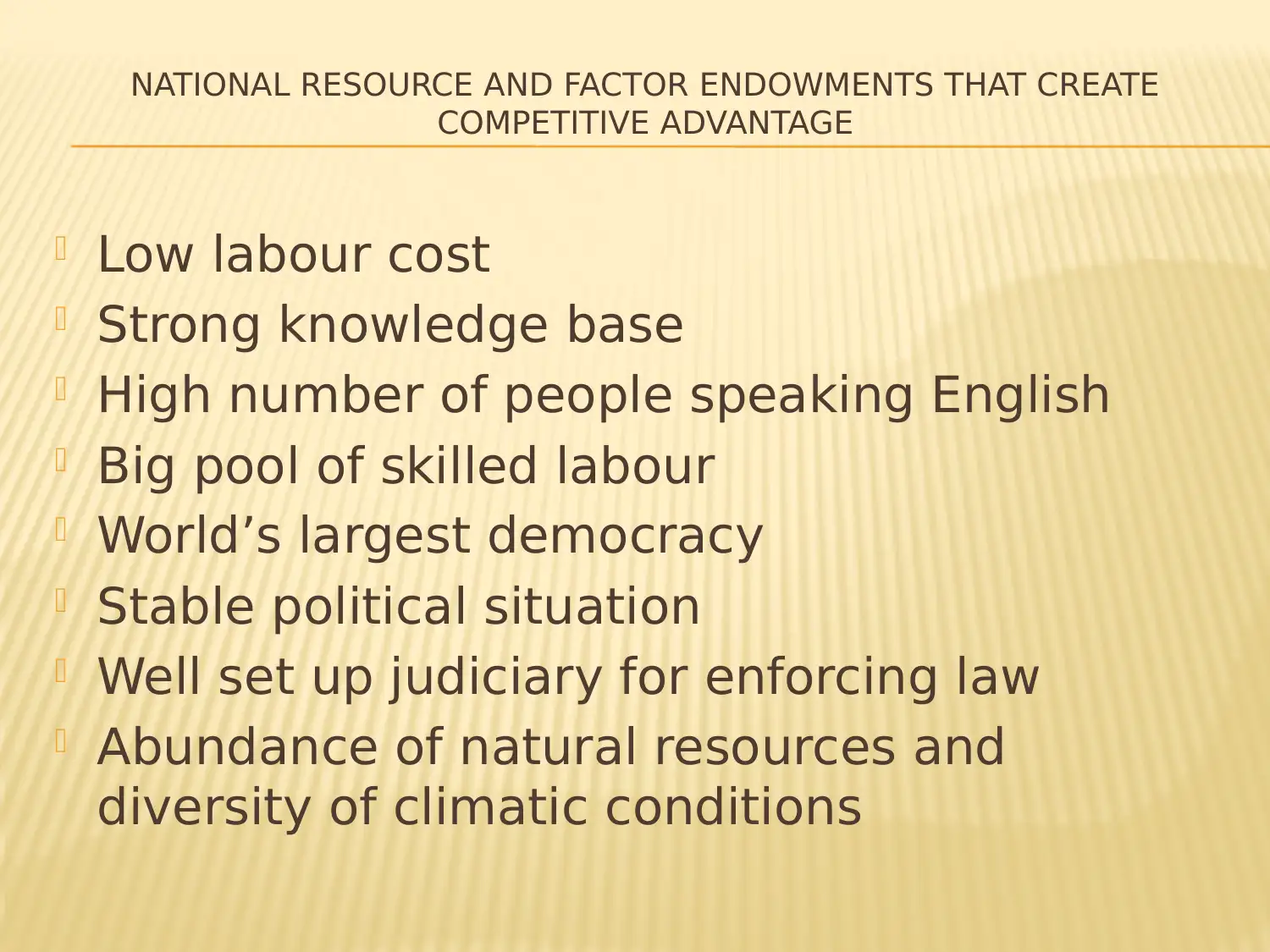
NATIONAL RESOURCE AND FACTOR ENDOWMENTS THAT CREATE
COMPETITIVE ADVANTAGE
Low labour cost
Strong knowledge base
High number of people speaking English
Big pool of skilled labour
World’s largest democracy
Stable political situation
Well set up judiciary for enforcing law
Abundance of natural resources and
diversity of climatic conditions
COMPETITIVE ADVANTAGE
Low labour cost
Strong knowledge base
High number of people speaking English
Big pool of skilled labour
World’s largest democracy
Stable political situation
Well set up judiciary for enforcing law
Abundance of natural resources and
diversity of climatic conditions
⊘ This is a preview!⊘
Do you want full access?
Subscribe today to unlock all pages.

Trusted by 1+ million students worldwide
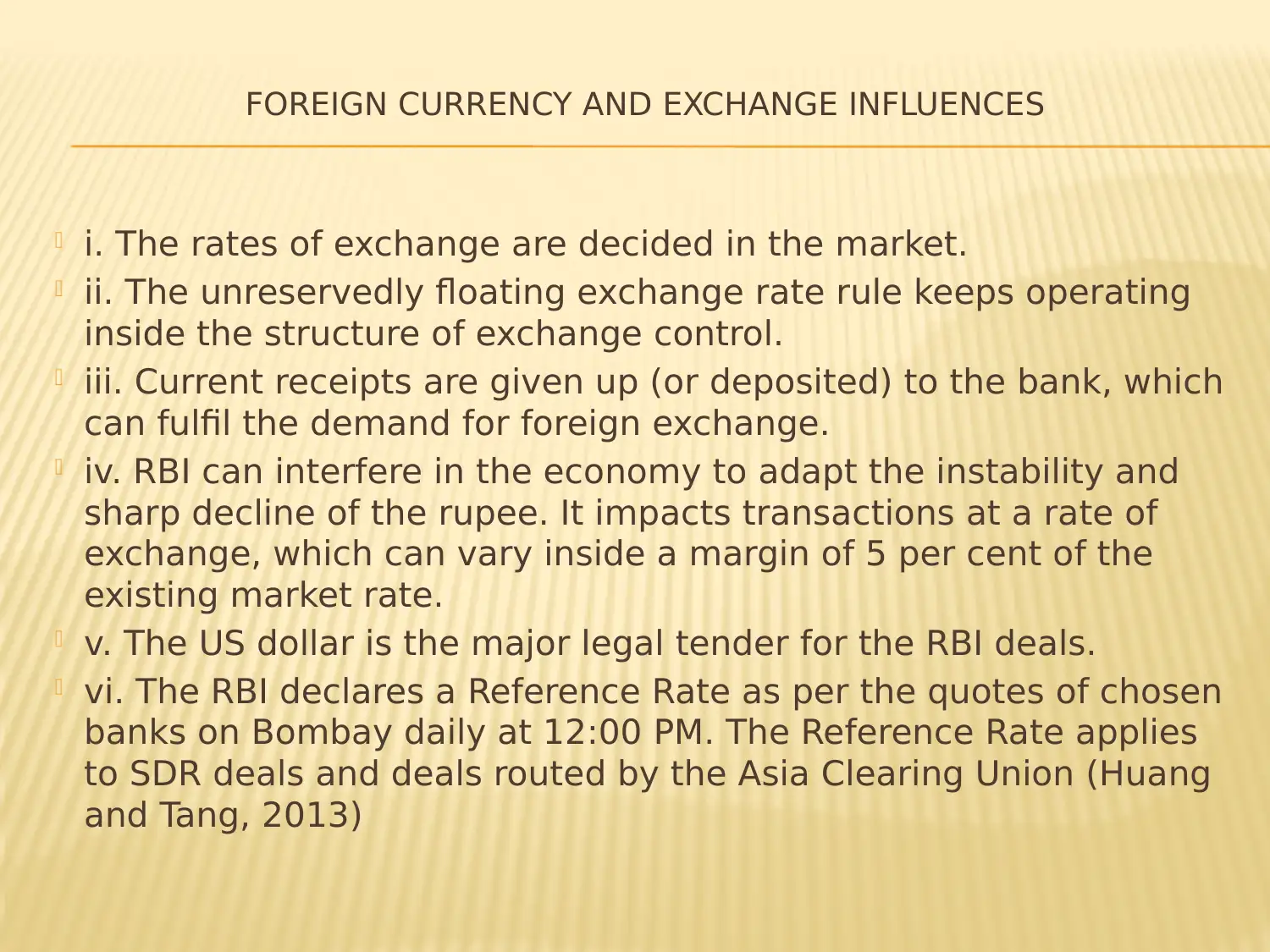
FOREIGN CURRENCY AND EXCHANGE INFLUENCES
i. The rates of exchange are decided in the market.
ii. The unreservedly floating exchange rate rule keeps operating
inside the structure of exchange control.
iii. Current receipts are given up (or deposited) to the bank, which
can fulfil the demand for foreign exchange.
iv. RBI can interfere in the economy to adapt the instability and
sharp decline of the rupee. It impacts transactions at a rate of
exchange, which can vary inside a margin of 5 per cent of the
existing market rate.
v. The US dollar is the major legal tender for the RBI deals.
vi. The RBI declares a Reference Rate as per the quotes of chosen
banks on Bombay daily at 12:00 PM. The Reference Rate applies
to SDR deals and deals routed by the Asia Clearing Union (Huang
and Tang, 2013)
i. The rates of exchange are decided in the market.
ii. The unreservedly floating exchange rate rule keeps operating
inside the structure of exchange control.
iii. Current receipts are given up (or deposited) to the bank, which
can fulfil the demand for foreign exchange.
iv. RBI can interfere in the economy to adapt the instability and
sharp decline of the rupee. It impacts transactions at a rate of
exchange, which can vary inside a margin of 5 per cent of the
existing market rate.
v. The US dollar is the major legal tender for the RBI deals.
vi. The RBI declares a Reference Rate as per the quotes of chosen
banks on Bombay daily at 12:00 PM. The Reference Rate applies
to SDR deals and deals routed by the Asia Clearing Union (Huang
and Tang, 2013)
Paraphrase This Document
Need a fresh take? Get an instant paraphrase of this document with our AI Paraphraser
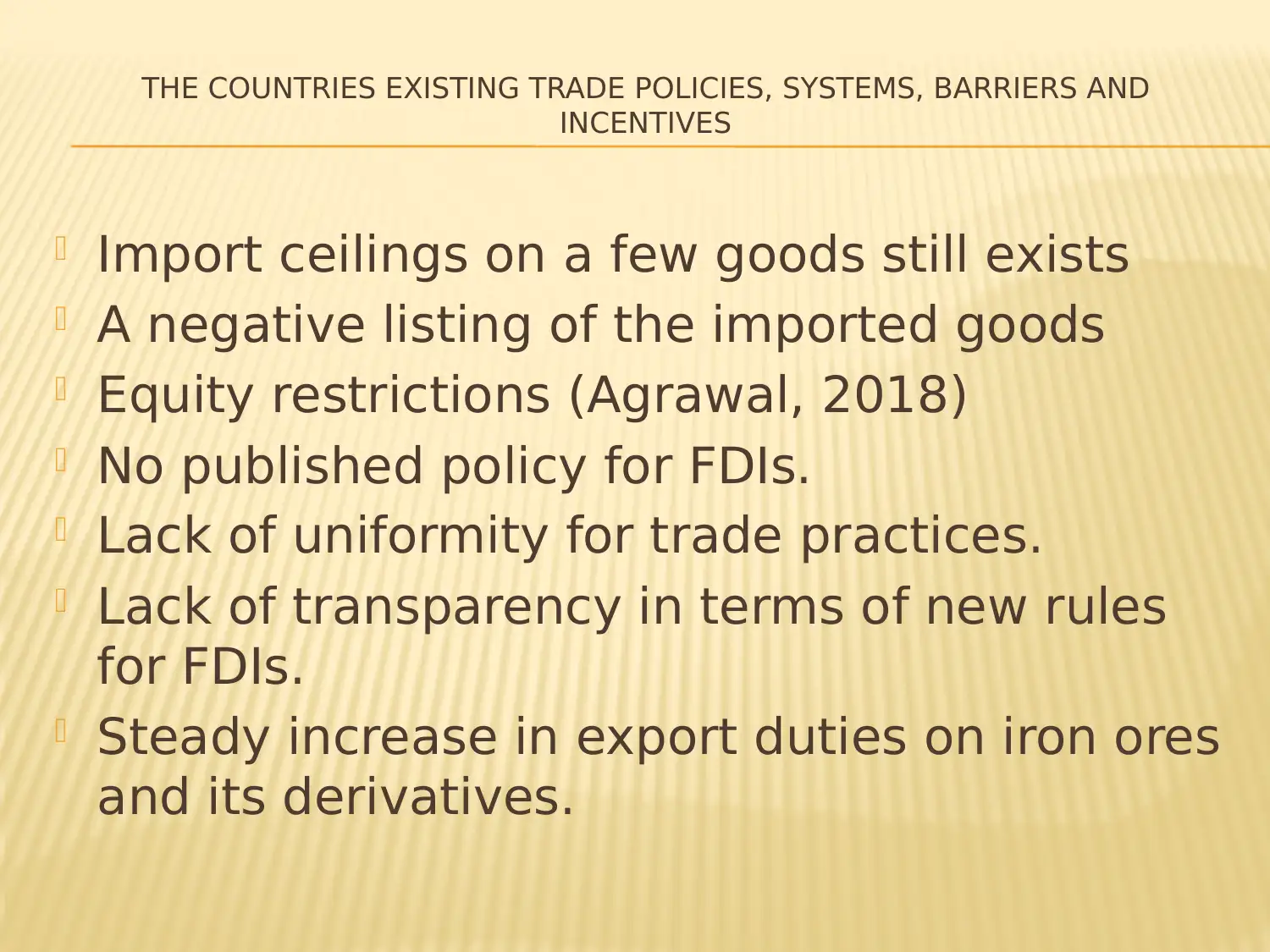
THE COUNTRIES EXISTING TRADE POLICIES, SYSTEMS, BARRIERS AND
INCENTIVES
Import ceilings on a few goods still exists
A negative listing of the imported goods
Equity restrictions (Agrawal, 2018)
No published policy for FDIs.
Lack of uniformity for trade practices.
Lack of transparency in terms of new rules
for FDIs.
Steady increase in export duties on iron ores
and its derivatives.
INCENTIVES
Import ceilings on a few goods still exists
A negative listing of the imported goods
Equity restrictions (Agrawal, 2018)
No published policy for FDIs.
Lack of uniformity for trade practices.
Lack of transparency in terms of new rules
for FDIs.
Steady increase in export duties on iron ores
and its derivatives.
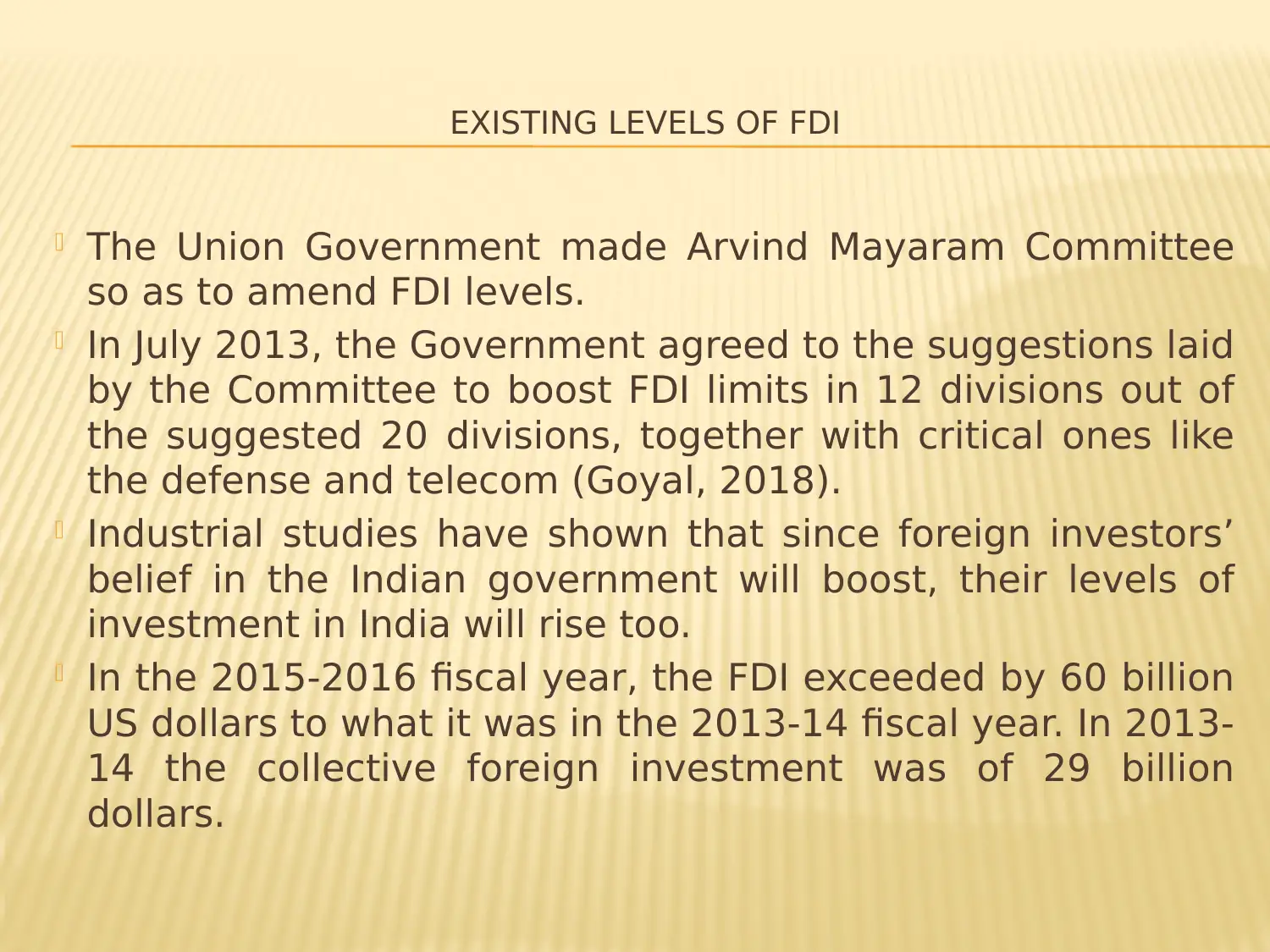
EXISTING LEVELS OF FDI
The Union Government made Arvind Mayaram Committee
so as to amend FDI levels.
In July 2013, the Government agreed to the suggestions laid
by the Committee to boost FDI limits in 12 divisions out of
the suggested 20 divisions, together with critical ones like
the defense and telecom (Goyal, 2018).
Industrial studies have shown that since foreign investors’
belief in the Indian government will boost, their levels of
investment in India will rise too.
In the 2015-2016 fiscal year, the FDI exceeded by 60 billion
US dollars to what it was in the 2013-14 fiscal year. In 2013-
14 the collective foreign investment was of 29 billion
dollars.
The Union Government made Arvind Mayaram Committee
so as to amend FDI levels.
In July 2013, the Government agreed to the suggestions laid
by the Committee to boost FDI limits in 12 divisions out of
the suggested 20 divisions, together with critical ones like
the defense and telecom (Goyal, 2018).
Industrial studies have shown that since foreign investors’
belief in the Indian government will boost, their levels of
investment in India will rise too.
In the 2015-2016 fiscal year, the FDI exceeded by 60 billion
US dollars to what it was in the 2013-14 fiscal year. In 2013-
14 the collective foreign investment was of 29 billion
dollars.
⊘ This is a preview!⊘
Do you want full access?
Subscribe today to unlock all pages.

Trusted by 1+ million students worldwide
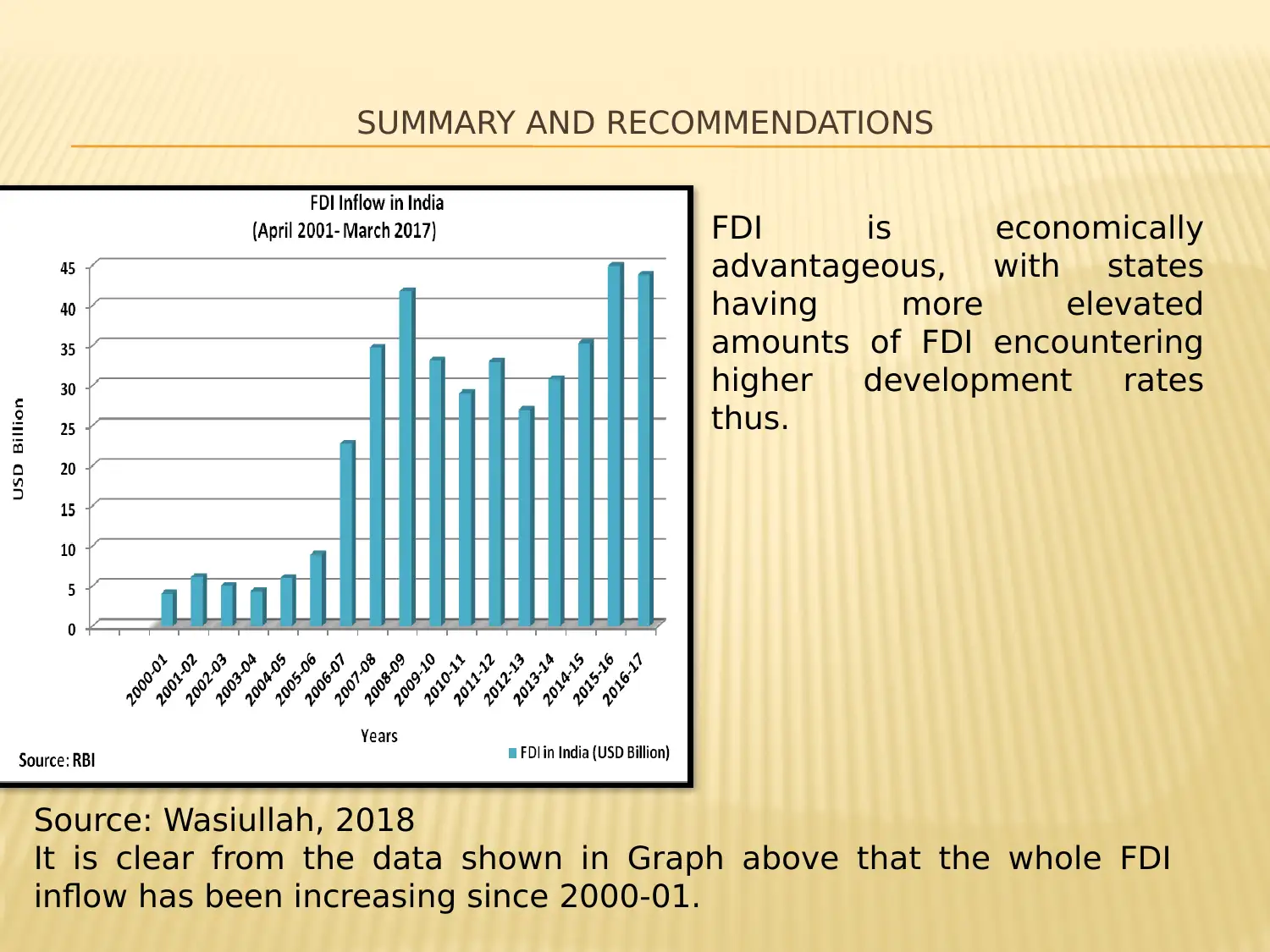
SUMMARY AND RECOMMENDATIONS
Source: Wasiullah, 2018
It is clear from the data shown in Graph above that the whole FDI
inflow has been increasing since 2000-01.
FDI is economically
advantageous, with states
having more elevated
amounts of FDI encountering
higher development rates
thus.
Source: Wasiullah, 2018
It is clear from the data shown in Graph above that the whole FDI
inflow has been increasing since 2000-01.
FDI is economically
advantageous, with states
having more elevated
amounts of FDI encountering
higher development rates
thus.
Paraphrase This Document
Need a fresh take? Get an instant paraphrase of this document with our AI Paraphraser
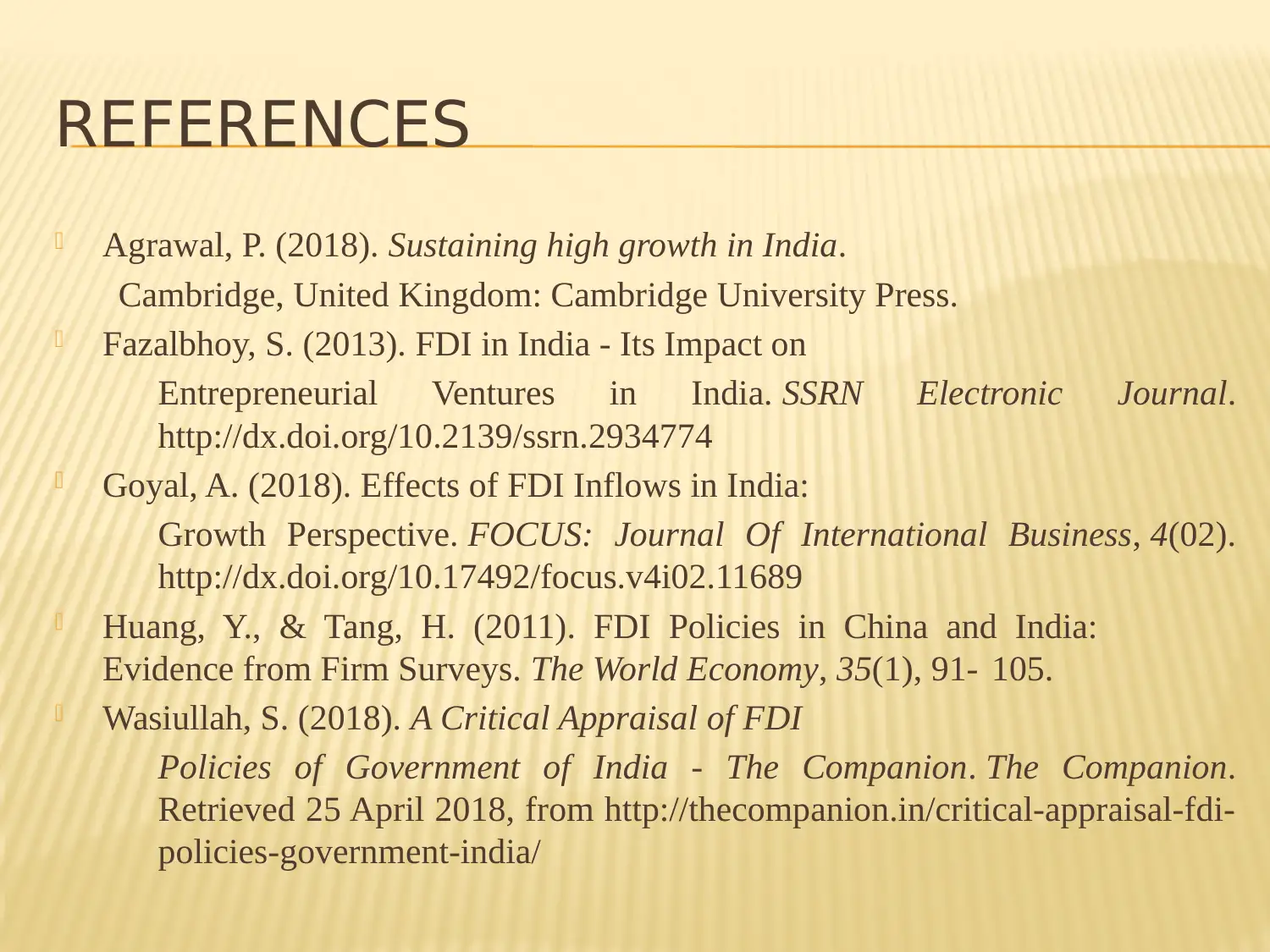
REFERENCES
Agrawal, P. (2018). Sustaining high growth in India.
Cambridge, United Kingdom: Cambridge University Press.
Fazalbhoy, S. (2013). FDI in India - Its Impact on
Entrepreneurial Ventures in India. SSRN Electronic Journal.
http://dx.doi.org/10.2139/ssrn.2934774
Goyal, A. (2018). Effects of FDI Inflows in India:
Growth Perspective. FOCUS: Journal Of International Business, 4(02).
http://dx.doi.org/10.17492/focus.v4i02.11689
Huang, Y., & Tang, H. (2011). FDI Policies in China and India:
Evidence from Firm Surveys. The World Economy, 35(1), 91- 105.
Wasiullah, S. (2018). A Critical Appraisal of FDI
Policies of Government of India - The Companion. The Companion.
Retrieved 25 April 2018, from http://thecompanion.in/critical-appraisal-fdi-
policies-government-india/
Agrawal, P. (2018). Sustaining high growth in India.
Cambridge, United Kingdom: Cambridge University Press.
Fazalbhoy, S. (2013). FDI in India - Its Impact on
Entrepreneurial Ventures in India. SSRN Electronic Journal.
http://dx.doi.org/10.2139/ssrn.2934774
Goyal, A. (2018). Effects of FDI Inflows in India:
Growth Perspective. FOCUS: Journal Of International Business, 4(02).
http://dx.doi.org/10.17492/focus.v4i02.11689
Huang, Y., & Tang, H. (2011). FDI Policies in China and India:
Evidence from Firm Surveys. The World Economy, 35(1), 91- 105.
Wasiullah, S. (2018). A Critical Appraisal of FDI
Policies of Government of India - The Companion. The Companion.
Retrieved 25 April 2018, from http://thecompanion.in/critical-appraisal-fdi-
policies-government-india/
1 out of 11
Related Documents
Your All-in-One AI-Powered Toolkit for Academic Success.
+13062052269
info@desklib.com
Available 24*7 on WhatsApp / Email
![[object Object]](/_next/static/media/star-bottom.7253800d.svg)
Unlock your academic potential
Copyright © 2020–2025 A2Z Services. All Rights Reserved. Developed and managed by ZUCOL.





